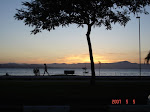 Florianopolis has a lot of sites that demonstrate human prehistorical inhabitation. This is a picture of a " oficina lítica" (or lithic oficine, I couldn´t find a correspondent in english), which are vestiges left by the prehistoric men who used basaltic rocks to sharpen or polish their stone´s instruments. This round formation they call polishers, which are circular depressions in a plate form, that results from the polish of intruments. After that they used this " plate" also to press grains.
Florianopolis has a lot of sites that demonstrate human prehistorical inhabitation. This is a picture of a " oficina lítica" (or lithic oficine, I couldn´t find a correspondent in english), which are vestiges left by the prehistoric men who used basaltic rocks to sharpen or polish their stone´s instruments. This round formation they call polishers, which are circular depressions in a plate form, that results from the polish of intruments. After that they used this " plate" also to press grains.This photo was taken in Naufragados beach, Florianopolis´extreme south, you can get there by boat or by an hour walk. There are other sites (that includes rupestrian draws) in the following beaches: Ingleses, Santinho, Armação, Campeche´s island and Barra da Lagoa.
Florianopolis possui vários sítios que demonstram a habitação pelo homem pre-histórico. Esta foto é de uma oficina lítica, que são vestígios deixados pela utilização de pedras basálticas para afiar ou polir instrumentos de pedra. Estas formações redondas sãao chamadas de polidores, que são depressões circulares em forma de prato, resultante do polimento de instrumentos. Também eram utilizados após para a prensa de grãos.
Esta foto foi tirada na praia de Naufragados, extremo sul da ilha, onde você pode chegar de barco ou em 1 hora de trilha. Há outros sítios (que também incluem pinturas rupestres) nas seguintes praias: Ingleses, Santinho, Armação, ilha do Campeche and Barra da Lagoa.





Welcome to CDPB. And thank you for your thoughtful comment at my site. This is an excellent post...great image and informative commentary.
ResponderExcluirI enjoyed this lesson in ancient history. We have similar stones here where the Indians made their corn meal.
ResponderExcluirYour visit will count and help me Make History. Pick a Peck of Pixels
Very interesting info.
ResponderExcluirThis is fascinating information. I would have thought those depressions were just caused by water erosion.
ResponderExcluirThat's really interesting. You certainly have a beautiful island.
ResponderExcluirHi, what a nice blog you have! I will take some time to browse through your pictures and stories of Florianopolis. Interesting name for a town...
ResponderExcluirCheers from Marcel
Well, they chose a very nice place to live! Since when has Floripa been populated?
ResponderExcluirHi Rob! Carijós Indians of the nation Tupi-Guarani were the inhabitants of Florianópolis area at the time of portuguese arrival. But are traces of the presence of other ancient populations in this area, verified through archaeological sites (like this one) and sambaquis with registrations of up to 4000 years ago. The Indians called the place Meiembipe or "mountain along the channel".
ResponderExcluir